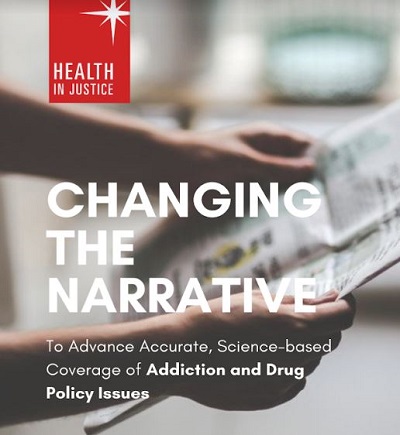I was interviewed about the myths and realities of drug courts with Changing the Narrative Webcast host and journalist Zachary Siegel (@ZachWritesStuff ) on Thursday, July 11, 2019.
Here is a link to Changing the Narrative’s Event page. The interview can be found at “July 11: Drug Court Webinar.”
 Below is a summary of my introductory and concluding remarks, a link to references, and other follow-up information.
Below is a summary of my introductory and concluding remarks, a link to references, and other follow-up information.
. . . . .
I really appreciate being asking to be a guest on Changing the Narrative’s webcast. It was an honor to meet you, Zach, Leo Beletsky, Sarah Wakeman, Maia Szalavitz, and over sixty other advocates to found this effort to use words about addiction that are supported by facts.
Before we start talking specifically about drug courts, I would like to provide some context.
In the United States, substance use is generally perceived, at best, to be an immoral act of self-pleasuring. At worst, it is perceived as a crime.
These are beliefs, not facts. The fact is that humans have used substances for over 12,000 years. According to research done by the National Institute of Alcohol and Drug Abuse – an unfortunate, stigmatizing agency title, by the way – people use substances for reasons that are meaningful to them. To paraphrase NIDA’s research findings, people use substances to feel better, to do better, to not feel bad, to not feel worse, and to connect.
So, substance use, and possession of substances to use, would be human. Not immoral. And not criminal.
However, beliefs about substance use, and about the people who use them, have generated an increasing number of laws about substance use and possession. Courtrooms and jails couldn’t hold all the people arrested. Many of those incarcerated for drug-related charges were rearrested. To address the high number of people in the legal system and high recidivism rates, an intermediate state was derived. Termed “drug treatment courts,” people arrested on drug-related charges would not be incarcerated but would be mandated to treatment.
The logic makes sense on some level. Requiring people who use substances to receive treatment would certainly seem likely to decrease the number of people in jails and prisons. And it should “fix those addicts” so they won’t be rearrested.
The logic, however, is based on beliefs, not facts, about substance use.
This is important. The people I have talked with who have been involved in founding drug courts actually had the best of intentions. They were trying to keep people with substance use issues out of jail. And they were trying to get them treatment, including medications.
Supporting drug courts, however, is based on a false, belief-based narrative.
One belief is that substance use is bad, period. The reality is that the vast majority of substance use is non-problematic, historic, normal, and human. However, we have established social norms that don’t jibe with human history.
Further, we have these tut-tut norms about some substances and not others. The data is clear but we wouldn’t know this from media coverage: alcohol kills more than twice the number of Americans as opioids.* But we don’t seem alarmed about deaths from the beloved substances we consume openly and plentifully in public.
Nearly 99% of Americans use some combination of the legal, experience-altering substances alcohol, nicotine, and caffeine. If we count food as a substance, over-consumption of food kills many times more than that.* We are arresting and incarcerating some people and not others, for using some substances and not others.
Another myth is that all people choose to use substances. The reality is that when people use substances, experience adverse consequences, then use the substances again and again, that means the brain is malfunctioning. Put your hand on a hot stove burner, your brain tells you to remove it. Put your hand on a hot stove burner, and you don’t remove it? That’s something up with the brain.
Indeed, that is what researchers have discovered. When substance use is repeated again and again despite the person experiencing negative consequences, that is defined as a medical illness involving the organ of the brain. This brain condition currently affects 1 in 10.
We have widespread access to this knowledge now thanks to the release in November, 2016, of Facing Addiction in America: The Surgeon General’s Report on Alcohol, Drugs and Health.** In this 400-plus page report, the Surgeon General and panels of experts describe the medical condition of addiction and prescribe a three-prong approach to treatment: medical care first, beginning with a visit to one’s primary care physician. Then individual counseling if needed. Medical care and medications may be sufficient. And, finally, again if needed, we can add what the report terms “recovery support services” which includes access to community social services agencies.
The myth that kills is that punishment treats addiction. The reality is that punishment does not treat any medical illness.
In sum, drug courts were founded on beliefs unsupported by science. The facts overwhelmingly demand the elimination of drug courts, not their proliferation.
In mid-2016, before the release of the Surgeon General’s report, Maia Szalavitz wrote in a letter to the editor of The New York Times, “Shame and stigma are the exact opposite of what fights addiction.” I used Twitter to ask her the equivalent of “Well, what does fight addiction?” She replied, “Love, evidence & respect.”
Those three criteria are useful for evaluating any conversation about substances and addiction. Let’s start with drug courts. Does the existence of drug courts, and do drug court policies, embody “love, evidence & respect”?
. . . . .
- Here are some steps you can take to challenge the narrative about drug courts in your locale.
- Here is a summary of my findings about drug courts, several of which I referred to in the interview.
- And here is my full report on drug courts, approximately 4,500 words.
*Sources
- Opioid-related deaths: 35,000 (2015: Source)
- Gun-related deaths: 35,000 (2014: Source)
- Alcohol-related deaths: 88,000 (2015: Source)
- Obesity-related deaths: 300,000 (Source)
- Tobacco-related deaths: 480,000 (Source)
**The Surgeon General’s Report, published in November, 2016, needs these updates:
- In terms of treatment effectiveness, research data does not support inclusion of 12-step approaches or rehab.
- Research does not support inclusion of naltrexone, or extended release naltrexone, as a primary treatment for opioid use disorder, equivalent to methadone and buprenorphine. Further, naltrexone may be contraindicated for those with liver disease and can be associated with depression. According to Buchel et al., November, 2018, “blocking opioid receptors decreases the pleasure of rewards in humans.”
#ChangingTheNarrative
Anne Giles, M.A., M.S., L.P.C., is a counselor in private practice in Blacksburg, Virginia.
The views expressed are mine alone and do not necessarily reflect the positions of my colleagues, clients, family members, or friends. This content is for informational purposes only and is not a substitute for medical or professional advice. Consult a qualified health care professional for personalized medical and professional advice.
